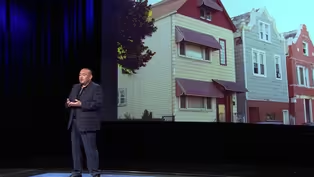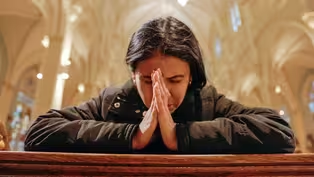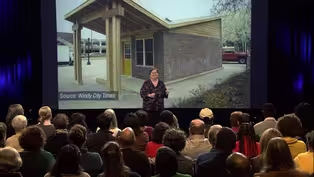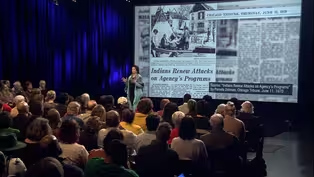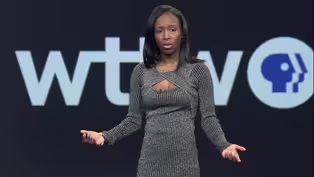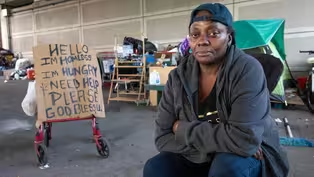FIRSTHAND
FIRSTHAND Talks: Tiny Homes, Big Solutions
Clip: Season 6 | 9m 34sVideo has Closed Captions
Tracy Baim examines the use of tiny homes one possible solution to homelessness.
Tracy Baim, co-Founder of Pride Action Tank and Windy City Times, examines the use of tiny homes one possible solution to homelessness and the affordable housing crisis.
Problems playing video? | Closed Captioning Feedback
Problems playing video? | Closed Captioning Feedback
FIRSTHAND is a local public television program presented by WTTW
FIRSTHAND
FIRSTHAND Talks: Tiny Homes, Big Solutions
Clip: Season 6 | 9m 34sVideo has Closed Captions
Tracy Baim, co-Founder of Pride Action Tank and Windy City Times, examines the use of tiny homes one possible solution to homelessness and the affordable housing crisis.
Problems playing video? | Closed Captioning Feedback
How to Watch FIRSTHAND
FIRSTHAND is available to stream on pbs.org and the free PBS App, available on iPhone, Apple TV, Android TV, Android smartphones, Amazon Fire TV, Amazon Fire Tablet, Roku, Samsung Smart TV, and Vizio.
Providing Support for PBS.org
Learn Moreabout PBS online sponsorship(audience applauding) - We have a migrant crisis in Chicago, but we've always had a homeless crisis in Chicago.
I'm gonna talk about one possible solution to that.
It's not the only solution, but it's certainly one that we should have on the table in Chicago, and that is tiny homes.
But first thing I'm gonna say what tiny homes are not because there's a lot of stereotypes about them.
They're not portable and move them around and hide from the zoning committee type of housing that exists in some places.
What we're talking about is permanent solutions and homes with beauty and dignity.
They are 300 to 500 square feet.
Basically think about a bungalow in Chicago and honey I shrunk the house.
It's a small footprint home that's all it is.
And you know what, we already have tiny homes in Chicago.
Most of them are micro apartments or studio apartments, or warehousing of seniors and the poor.
We already do 350 to 400 square foot homes and some of them are like $2,000 a month, right?
So vertical housing is needed in certain areas of Chicago where the land is just too valuable.
But you know what?
Chicago has a lot of land and it has a lot of areas that have been left vacant for years.
So we do have the land and we do have the transit.
These homes can be built any which way any home is built, right?
So some can be brick, some can be prefab, manufactured, they can be stick built on site, all sorts of homes including container conversion homes.
Who's gonna be in these homes?
Well, you know what?
We need to make sure that these homes are not just for people who are formerly homeless, people who are seniors and veterans and folks from all walks of life have wanted tiny homes in Chicago.
They wanna be able to afford to live in Chicago, either because they wanna be, for the economic reasons or the environmentally friendly reasons, or they just wanna be in a central area and not have to go far away from where their jobs are, in order to afford to live.
So we already do have tiny homes, we just need to make a horizontal approach to tiny homes in Chicago.
So we did a tiny home summit a few years ago, which I'm gonna talk about.
And one of the presenters at that was a Dallas project.
It's been operational now for six years.
It cost $8 million, 50 tiny homes with bathrooms and kitchens.
So we have models out there, there's other cities that are doing this.
But you know what?
Chicago can do it best.
In 2012 in Chicago, there was a lot of racism happening within the gay community along the Halsted Corridor.
Where there were a lot of African American Latino youth who were housing unstable.
And you had a lot of white gay business owners who were upset with what they perceived as crime caused by those youth.
So we did a three month investigation.
We interviewed a bunch of youth service providers.
We created a series called Generation Halsted, won a bunch of awards and then nobody asked us for our data and nobody really could do anything with it because a lot of service providers have specific funding tracks and they can't always think outside the box.
So what we did in 2014 was we did a youth homeless summit.
We brought a hundred youth who are currently or recently homeless, to the table, most of them LGBTQ, but not all.
And then we learned a whole lot of things from those youth.
They told us things that would solve their day-to-day problems, whether that's showers, laundry, a place to sleep.
And then we brought the media in and we brought funders in.
And they heard firsthand from youth about what was going on in their lives.
And then we also talked about solutions.
But one idea was tiny homes.
And I'm telling you, the youth got so excited drawing an example of what they could live in.
So funders got excited 'cause the youth were excited.
Alphawood Foundation, Polk Brothers Foundation and others joined with the American Institute of Architects and Pride Action Tank, the organization Kim Hunt and I founded and we did an international design competition for tiny homes.
More than 200 entries from around the world they were gorgeous, beautiful, everything.
The youth consulted on it because these were gonna be for youth who were in community college who needed housing.
So that was the model.
$5,000 prize three Chicago architects won it.
Then Alphawood paid to build it outside of a Tiny Home summit in 2016.
Here it is, it was beautiful, it was brick, wood, full kitchen, ADA accessible bathroom, a small living room and a small bedroom.
And we had politicians there and it was universally loved.
Two of the youth that I worked with during that process and still I'm connected with today, one is Breezy Connor.
Breezy was the inspiration for the Chicago Youth George Initiative.
She told a story at our summit.
It was 20 below zero in Chicago and she had two bags with her and she didn't have a place to stay that night.
And she had to choose between a bag of school books.
'cause she really wanted to get her education and a bag with her medications, her family photos and everything else.
And she had to pick one.
And then the next one was Casey White.
Casey had been in the documentary, called "The Home Stretch" and told her story of living on the streets kicked out for being gay and struggling through the systems.
Why Chicago, why now?
68,000 people are housing unstable in this city and that was before the migrant migrant crisis.
So we have a housing problem.
A lot of those folks really just need a place to live.
They can afford the place to live that if it was reasonably priced, if we concentrated on probably the 80% of the people that really just need affordable housing, we can then put them in the housing and work on the 20% that have a lot higher needs.
So Chicago, I believe, can do this best and at scale.
There is land, there is transit, and we have an infrastructure that is really solid.
We also have resources.
We have extremely bright, vital organizations serving these communities already that are part of the solution.
The Chicago Housing Authority has money and land and they need to use that to build homes.
And when you build homes, CHA, also build them as lease to own so that we can generate wealth in communities that we're sidelined because of redlining.
We also have a lot of land, like in the medical district, we have old warehouses, we have retails.
So let think about communities.
All these communities with vacant storefronts basically that are tax write-offs for landlords.
Take those, convert them to tiny businesses with tiny homes behind them.
So why do I think this is also viable?
It's cheaper.
Affordable housing units are ridiculously expensive to build.
You have 20 layers of bureaucracy in everybody's hand in the pocket.
When you build a vertical housing, which we still need, not against, but each unit costs over $400,000 because you have elevators and infrastructure and all the things you need to build plus the land, right?
Tiny homes really depends on how exactly you build them but usually about 20% of the cost, right?
Way under a hundred thousand if you do it, especially if you do it to scale, not just one at a time in different places.
They can be environmentally net zero.
I think we can build these through the unions, cooperating and training people, the migrants, people coming outta prisons, you name it.
These can be educational opportunities because they're very simple to build, right?
So we need 'em at scale.
We need 'em for all populations.
When we had the home and back of the yard, seniors would come up and say, well I could actually afford that and it would mimic how I grew up in a bungalow, instead of being in this cold elevator building where I don't know anybody.
Beauty and dignity, that's what we need to make sure gets across.
So what are some of the barriers here?
Well, some people don't care about people.
Let's just start there.
So if you don't care about people, I got good news for you.
There's a model called Housing First that other cities do that actually shows that it's cheaper to house people first, Housing First.
Chicago needs to adopt Housing First because we are spending so much money, temporary solutions as well as horrible solutions.
So people who are housing unstable interact with police, emergency rooms, streets and sanitation, prisons, at a high, high rate.
They're also victims of crime at a highest rate, right?
So if we want to save money, we can put them in Housing First and then get them into other resources for food and counseling and substance abuse, et cetera, et cetera, so that works.
I'm still doing this work 'cause I'm still friends with some of the youth I met who are now in their thirties and I see how the system is insane around them.
Not only do I know that even if they might have been in the system, that they have some interconnected families that in many ways aren't enhancing their lives, but they also support.
But the systems are too big for any one of us to change.
I cannot change this alone, but I believe Chicago has the solutions where we can change it together.
We actually have enough land and resources and people power to solve this.
Dozens of organizations, thousands of people are already working on the solutions.
We just need to resource them better and better use our land, transit and infrastructure to meet all of the needs of the homeless.
But tiny homes are just one of the many solutions we need.
There is no one solution to solve this, but it is one of those that we need to add to the menu of solutions in Chicago, so that we can bring Chicago home.
(audience applauding)
FIRSTHAND Talks: The Power of Housing
Video has Closed Captions
Clip: S6 | 7m 39s | Jose Muñoz shares his childhood experience facing homelessness and food insecurity. (7m 39s)
FIRSTHAND: Homeless — The Migrant Experience Trailer
Preview: S6 | 29s | WTTW shares five migrant stories, revealing why they left home, their journeys, and their struggles. (29s)
FIRSTHAND Talks: Tiny Homes, Big Solutions
Video has Closed Captions
Clip: S6 | 9m 34s | Tracy Baim examines the use of tiny homes one possible solution to homelessness. (9m 34s)
FIRSTHAND Talks: Invisible No More
Video has Closed Captions
Clip: S6 | 8m 43s | Shelly Tucciarelli explores affordable housing development for Native Americans. (8m 43s)
FIRSTHAND Talks: Finding a Way Home
Video has Closed Captions
Clip: S6 | 5m 21s | Sharday Hamilton shares how public services failed her as a homeless teen mother. (5m 21s)
FIRSTHAND Talks: Building Our Way Out
Video has Closed Captions
Clip: S6 | 9m 20s | Nicole Bahena puts focus on using available funding to create affordable housing. (9m 20s)
Video has Closed Captions
Preview: S6 | 1m 19s | WTTW offers a look at the unique perspectives and challenging experiences of the unhoused. (1m 19s)
Providing Support for PBS.org
Learn Moreabout PBS online sponsorshipSupport for PBS provided by:
FIRSTHAND is a local public television program presented by WTTW
